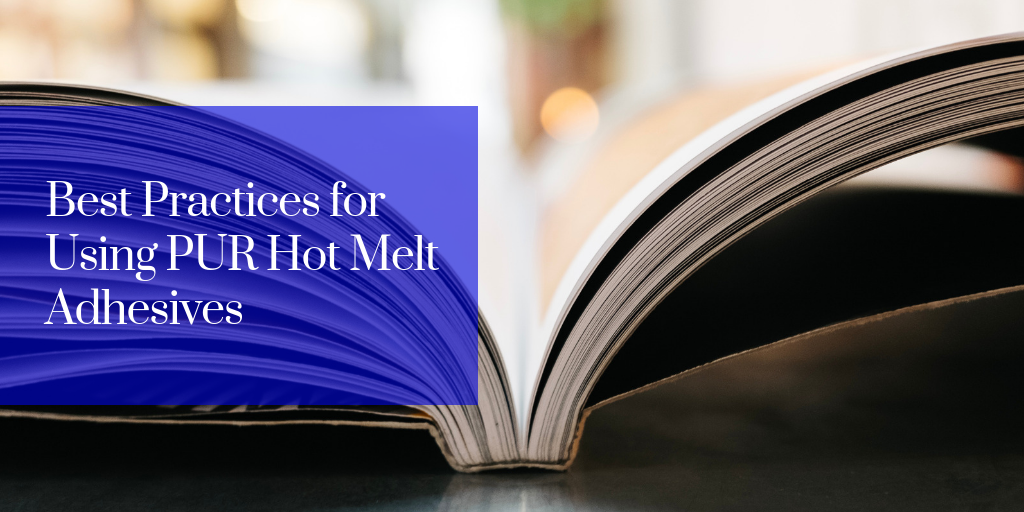Polyurethane reactive glue, or PUR, is a synthetic material used frequently in volume manufacturing and home repair. First invented in the 1930s, polyurethane hot melt was used as a less expensive alternative to rubber but has since been refined and has expanded to be one of the most popular adhesives in manufacturing. So why is PUR adhesive so appealing, and what are the best practices for using PUR hot melt in your production?
Why choose PUR Hot Melt for your application?
Although hot melt adhesives have been around for decades, advancements in PUR development have made it popular for applications like bookbinding, woodworking, and packaging starting in the 1950s. Since it is highly flexible and has a broad thermal setting range, PUR is perfect for bonding difficult substrates.
Significantly stronger than traditional hot melt, PUR hot melt provides adhesive strengths greater than 1,000 lbs! This is due to the PUR polymerizing when it comes into contact with moisture in the air. The crosslinking polymerization causes the adhesive to form a stronger bond than other hot melt glues after the curing process is finished.
PUR also has a low volatile organic compound (VOC) content when compared with other hot melt adhesives, making it a more eco-friendly alternative. Most PUR adhesives do require 24 hours to cure fully, and their strength is increased by reacting to moisture in the air, so it is vital to expose PUR to air during the drying process.
Key Characteristics of PUR Hot Melt
- Creates a bond stronger than 1,000 lbs
- Flexible and can be hard set or rubbery once cured
- Works with hard-to-bond, nonporous substrates
- Tolerates a wide temperature range, making it suitable for indoor and outdoor use
- Works well with difficult substrates, coating, and inks
- High-quality bonds can be made using less adhesive than other hot melt glues
- No mixing is required
- Fast curing time
Popular Applications for PUR Hot Melt
While many industries are using PUR hot melt in their manufacturing process, we are frequently asked how a business can incorporate PUR into their production. Hot melt adhesives are applied in many industries to maximize ease of use, reduce labor time, and take advantage of temperature and moisture tolerances. Every industry is different, and we listed some of the most popular applications for PUR hot melt below.
 Bookbinding
Bookbinding
PUR adhesive is often used for perfect binding. While traditional perfect binding uses EVA glue or animal glue, PUR is an effective and efficient alternative. Using PUR adhesive makes bookbinding more durable and causes less cracking because the glue is more flexible after curing than EVA or animal glue.
 Packaging
Packaging
PUR hot melt provides a stronger bond and a faster cure time than some traditional hot melt glues, making it popular with industrial packaging manufacturers for applications from shipping containers to cosmetics.
PUR can also dry clear, making it easy to hide glue lines and give the appearance of continuity in a glued material.
 Woodworking
Woodworking
Using PUR to assemble wood furniture can help eliminate the need for additional screws and fasteners.
Many craft makers turn to PUR as their go-to adhesive because of its fast drying and high strength properties.
 Construction
Construction
Due to its ability to bond to non-porous substrates, PUR is great for use in construction. Its high strength can hold hard-to-bond materials together without additional fasteners. PUR adheres to wood, glass, plastic, and most metals. Its fast drying time and bond strength make PUR a suitable adhesive for automated assembly as well.
Best Practices for Working with PUR Hot Melt
1. Safety first—hot stuff coming through!
At some point, you’ve probably accidentally burned yourself with a hot glue gun used for crafting. Now imagine touching a larger industrial closed melt dispenser between 180°F to 280+°F. Ouch! Commercial hot melt like PUR needs to be handled with care, and you should protect your skin from molten glue using gloves and safety glasses. Be careful to not touch the adhesive applicator’s heat cylinder, cartridge, or dispenser when in use. Also, do not apply PUR to heat-sensitive materials.
2. Test for success
Before starting your project, test how well hot melt adheres to your chosen substrate. Apply a little bit of hot melt to a piece of scrap material and wait for it to cure before tackling larger aspects of your project. By taking the time to test, you can understand if PUR hot melt is right for your current project before committing to gluing it together.
3. Proper Storage
To extend the life of the glue, store it in a cool, dry place. PUR adhesive most often comes in slugs, pails and drums, which are closed systems to help preserve the glue. The standard shelf life of a PUR glue is about one year.
If you are having any difficulty using or storing hot melt, the experts at LD Davis are here to help! Check out our hot melt troubleshooting guide.
PUR Hot Melt vs. EVA Hot Melt
Those interested in how best to use PUR hot melt have probably come across EVA adhesives and wondered, what’s the difference between the two? Both types of glues are suitable for perfect binding and packaging, but PUR is the more durable of the two and offers better flexibility and durability for all applications.
Benefits of EVA Adhesives
EVA glue uses an open dispensing system, which requires less of a start-up cost for manufacturing. EVA glue also has a faster drying time, lasts longer, and requires less cleanup; however, it is less flexible than other hot melt glues. Due to its fast cure time and ease of use, EVA hot melt is popular for use in bonding applications like packaging, graphic arts, and general assembly work.
Benefits of PUR Adhesives
PUR glue uses a closed dispensing system to heat the adhesive and then disperse it onto the desired substrate to dry. PUR adhesive takes longer to harden than EVA because it requires exposure to moisture cure, but it creates a stronger, more flexible bond in the end. The strength and flexibility of PUR hot melt make it the go-to choice for perfect binding, general assembly, packaging, and woodworking.
Perfect Binding With PUR Hot Melt
Technically, PUR binding is perfect binding; it’s just accomplished using PUR glue rather than EVA. Perfect binding is a fast and inexpensive way to bind paperback books by gluing the pages together at the spine. Because of the 1,000 lbs strength of PUR combined with its flexibility, PUR hot melt has quickly become the preferred adhesive to use for perfect binding because it can hold up to repeated use and requires less adhesive than EVA.
Working with specialty papers, inks or coatings? PUR is a great adhesive to use because it is less affected by tough-to-bond substrates. Another benefit of PUR glue over EVA for perfect binding is the lay flat capability, which is especially favorable for photo book binding.
We’re often asked by customers, can you use PUR glue in a perfect binding machine, and the answer is yes! PUR requires a closed system for perfect binding to keep it from interacting with the moisture in the air.
Want to know more about using industrial polyurethane glue?
If you are interested in using PUR glue in your project, want to know how PUR hot melt can compliment your manufacturing process, or are looking for a glue supplier, contact the adhesive experts at LD Davis.







